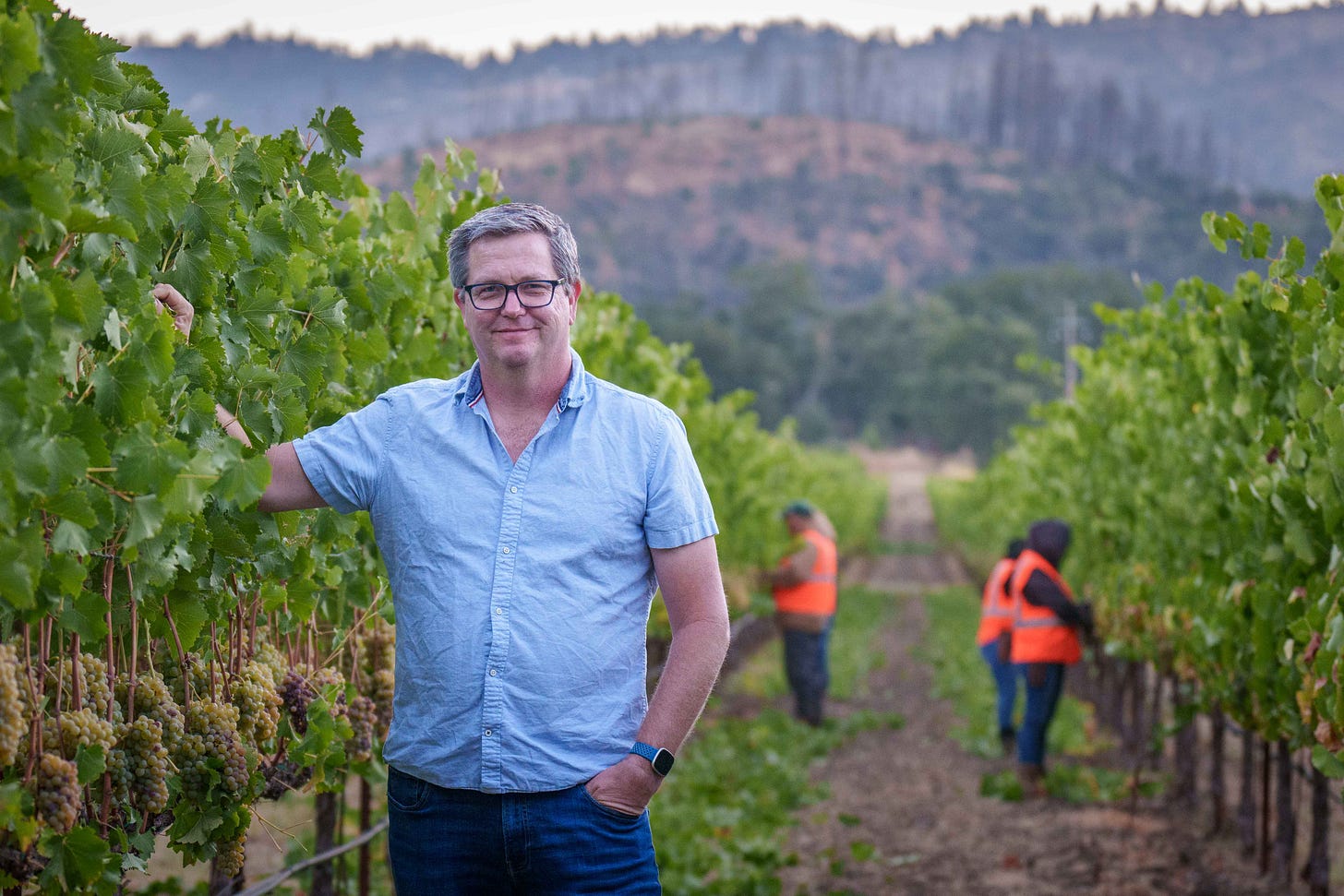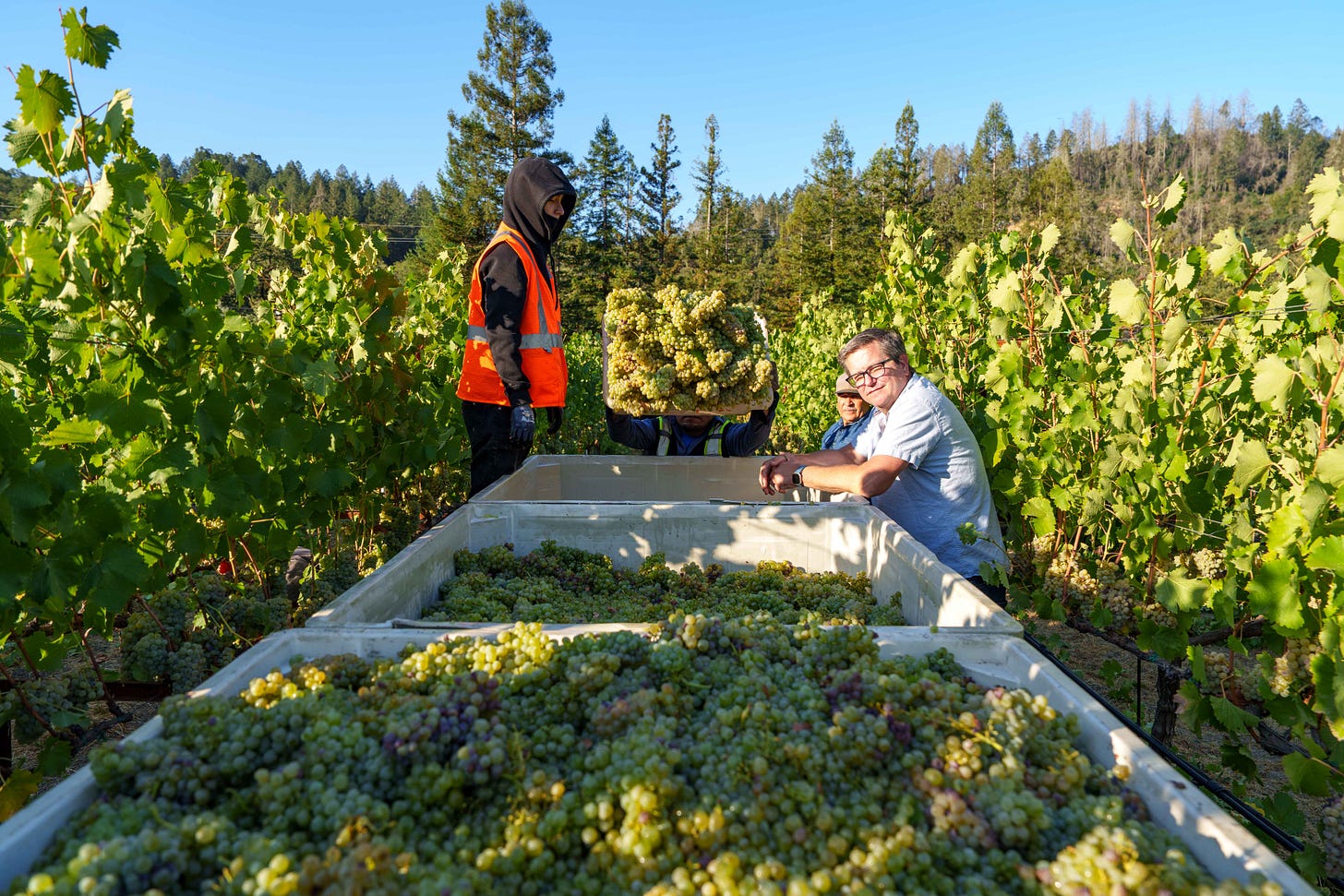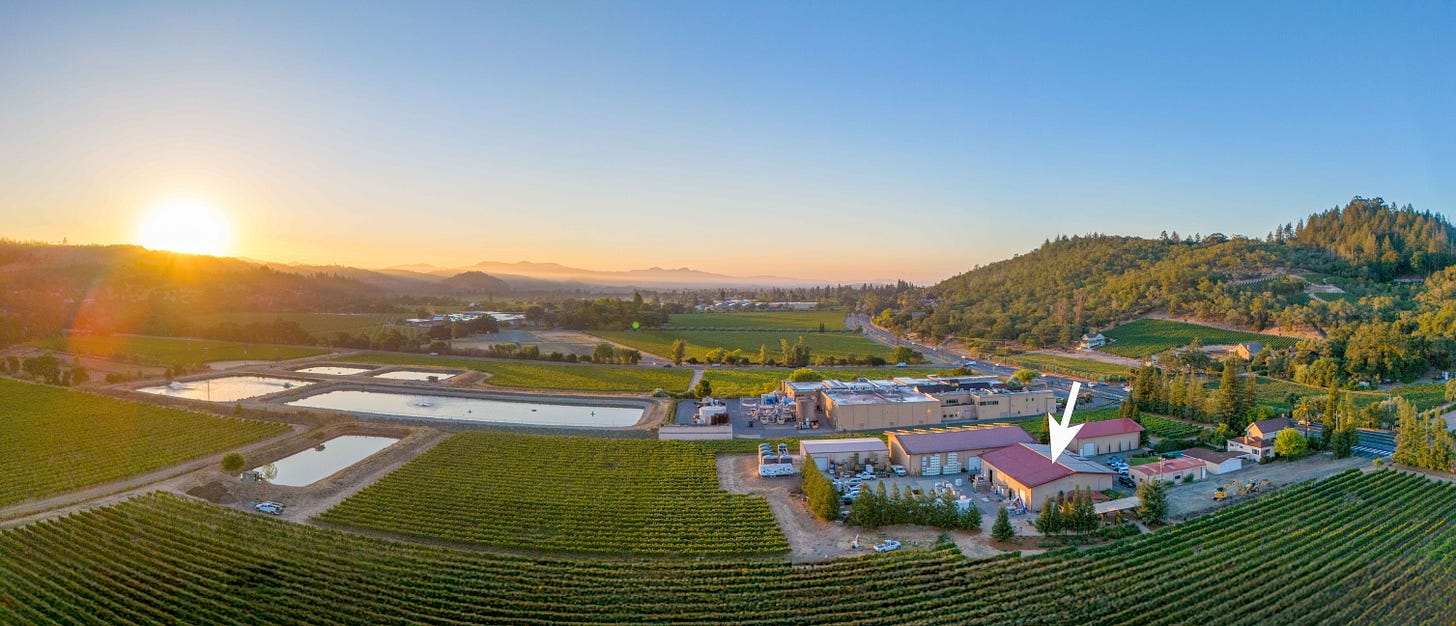Editor’s note: Dan Berger will be back next week.
ST. HELENA, Calif. — Ballentine Vineyards, located just off Highway 29 and surrounded by well-known names such as Charles Krug and Revana, may not stand out at first glance. But behind its modest exterior lies a family-owned winery with a deep connection to Napa Valley’s winemaking history. This year marks a significant milestone for the vineyard: winemaker Bruce Devlin’s 25th anniversary. His long tenure reflects both his own dedication to the craft and to the Ballentine family’s vision of preserving tradition while producing high-quality wines at refreshingly reasonable prices, despite being in one of the most exclusive and high-priced wine neighborhoods in Napa Valley.

“Bruce was an integral part of a very smooth transition between my aging parents and myself,” wrote Frank Ballentine, fourth-generation owner of the winery and vineyards and a St. Helena native, in an email. “With Bruce’s guidance, we have seen our wines evolve, each vintage telling its own story. He has an uncanny ability to capture the essence of our vineyards, creating wines that reflect our terroir and showcase his passion, skill and artistry.”
A Legacy of Family Farming
Ballentine Vineyards traces its roots back to the early 20th century, when the Pocai family first planted grapes in Napa Valley. Frank’s parents, Van and Betty Ballentine, founded the winery in 1992, though their connection to the land runs much deeper. Betty once worked as Robert Mondavi’s secretary at Charles Krug, while Van oversaw vineyard operations at Christian Brothers Winery.
Unlike many Napa Valley wineries that have shifted toward planting only cabernet sauvignon, Ballentine has embraced lesser-grown varietals such as malvasia bianca, chenin blanc and petit verdot.
“We don’t follow the crowd,” Devlin said. “We let the land tell us what it needs, and we make wine that speaks to that.”
“It is very rewarding to be part of a fourth-generation vineyard and winery business in Napa Valley,” Frank wrote. “It is also humbling to think back and know that my great-grandfather on my mom’s side and grandfather on my dad’s side started the business 119 years ago. My grandparents and parents stuck with the business through many difficult times, which serves as a great reminder and inspiration for us in today’s challenging wine market.”
Ballentine’s vineyards, each with its own distinct terroir, are central to their philosophy of letting the land guide which varietals are grown.
Fig Tree Vineyard, purchased in 1949, is located on the northeastern edge of the St. Helena appellation. The site’s rocky and loamy soil, along with its late-day exposure to the sun, creates ideal conditions for producing wines with complex tannin structures. The vineyard is home to some of Ballentine’s most prized estate-grown wines, including malbec, cabernet sauvignon, petit verdot and merlot. Two fig trees, one gifted to Van Ballentine from Italy, mark the property.
“Fig Tree Vineyard is special because its location naturally devigorates the vines, resulting in wines with elegance and texture,” Devlin said.
Frank’s great-grandparents purchased Pocai Vineyard in 1905 for $10 in gold coins. Located off the Silverado Trail in the Calistoga AVA, this vineyard is known for its Bale gravelly loam soil — rocky with excellent drainage. The vineyard produces bold red wines, including cabernet sauvignon, zinfandel, malbec and petit verdot, with expressive, robust tannins.
Betty’s Vineyard, located next to the winery just north of St. Helena, was purchased in 1944 and named after Betty Ballentine. It is where the family’s home and winery stand today. The vineyard is known for producing delicate white wines and is the largest acreage of chenin blanc in Napa Valley. It also hosts one of the few remaining plantings of malvasia bianca. The proximity of the vineyard to the winery allows for careful handling of the grapes, preserving the freshness and acidity of the wines.
Bruce Devlin’s Journey to Napa
Devlin’s path to winemaking wasn’t straightforward. Initially his interests were in forestry and photography.
“I always loved science,” he said. “But winemaking gave me a way to combine it with creativity. Once I discovered fermentation and realized I could make something people would enjoy with family and friends, I knew it was the perfect fit.”
In 1994 Devlin participated in a student work exchange at Weingut Reichsrat Von Buhl in Germany’s Pfalz region, where he developed an appreciation for how tradition and technique influence wine.
“Germany showed me the balance between the science and artistry of wine,” he said.
This experience, coupled with his studies in fermentation science at UC Davis, shaped his approach to winemaking at Ballentine Vineyards.
“Every harvest, my goal is to capture the quality and expression of each block of our 100 acres, exploring its potential in an interesting way,” Devlin said.
This philosophy has guided him through more than two decades of crafting wines that embrace the vineyard’s natural characteristics, particularly those from lesser-known varietals.
The Wines of Ballentine Vineyards
Ballentine Vineyards’ current release showcases the diversity of its estate-grown wines, offering both whites and reds that vary in style and complexity. The lineup includes the aromatic 2022 Malvasia Bianca from Betty’s Vineyard ($40 per bottle), the 2021 Sparkling Malvasia Bianca ($55 per bottle) and for red-wine lovers the approachable 2021 Estate Merlot ($50 per bottle), the structured 2021 Reserve Zinfandel ($70 per bottle) and the elegant 2021 Reserve Cabernet Sauvignon ($150 per bottle). Other notable reds include the 2021 Estate Cabernet Sauvignon ($60 per bottle), the 2021 Malbec from Fig Tree Vineyard ($75 per bottle) and the 2021 Cabernet Franc from Pocai Vineyard ($80 per bottle).
Although all of the wines are well-crafted and reflect Ballentine’s commitment to quality, two wines in particular stood out in a recent tasting for their distinctive profiles: Betty’s Vineyard Chenin Blanc and Fig Tree Vineyard Merlot.
Chenin Blanc: A Reflection of Family and Tradition
Once the most widely planted grape in Napa Valley, chenin blanc is now a rarity. Yet Ballentine remains Napa’s largest grower of this varietal, thanks to Devlin’s foresight in the early 2000s. At a time when most wineries were pulling out their chenin vines in favor of more popular white-wine options such as sauvignon blanc, Devlin convinced Van Ballentine to preserve the chenin blanc in Betty’s Vineyard.
“We wanted to be different,” Devlin explained. “Everyone else was making sauvignon blanc, but we saw something special in chenin.”

Betty’s Vineyard produces grapes that retain vibrant acidity, even in Napa’s warm climate, making chenin blanc a perfect fit for the site.
“Chenin blanc is special to us because it’s a reflection of our family’s history and dedication to the land,” Devlin said. “It’s a varietal that’s easy to overlook, but once you experience its freshness and complexity, it’s unforgettable.”
The 2022 Betty’s Vineyard Chenin Blanc ($35 per bottle) is a vibrant wine with aromas of lemongrass, lime and green apple. On the palate, flavors of grapefruit, kiwi and pineapple dominate, finishing clean and balanced. This dry wine pairs beautifully with grilled fish or a fresh summer salad, showcasing the bright citrus notes and lively acidity that have made it a favorite among wine-lovers. Visitors to Ballentine can enjoy this wine while strolling through Betty’s Vineyard or relaxing on the terrace.
Merlot: A Commitment to the Land
While much of Napa Valley has shifted toward cabernet sauvignon, Ballentine has remained committed to growing varietals where they thrive naturally, allowing the land to dictate what’s best. This philosophy is especially evident in the Fig Tree Vineyard, where the rocky, sun-drenched soil provides an ideal environment for producing complex merlots.
“We’re putting other grapes in places where we could plant cabernet, but we want to focus on making really great wine,” Devlin said.
Devlin’s approach is about understanding the land and choosing varietals that will produce the best expression of the vineyard, even if it’s not the most commercially viable choice.
“It’s not the easiest or most economical decision,” he said, “but it’s the right decision for the land and the wine.”
The 2022 Fig Tree Vineyard Merlot ($75 per bottle) reflects this commitment. The wine is full-bodied and complex, with layers of dark raspberry, plum and herbal notes such as dried sage. Rich but smooth tannins provide structure, while hints of spice and mocha linger on the finish. This merlot pairs beautifully with grilled lamb chops or mushroom risotto, highlighting the depth and character of the vineyard’s terroir.
The Future of Ballentine Vineyards
As Ballentine Vineyards looks to the future, the winery is entering a new phase with renovations to its tasting room and a renewed emphasis on direct-to-consumer sales. Devlin is well aware of the challenges ahead. With slowing wine demand and a surge in new Napa Valley brands, competition has never been fiercer. He sees these shifts as an opportunity rather than a setback. For him, it’s a chance to focus on what Ballentine does best: Create wines that honor the specific character of each vineyard at prices that offer exceptional value in a region where bottles routinely climb into the hundreds of dollars.
“We’re focused on producing the best wines our vineyards can offer and making sure they remain accessible,” Devlin said.

In an era where many Napa wineries follow market trends or prioritize profit, Ballentine stands firm in its approach. The family’s commitment to producing wines that reflect the land’s distinct personality remains central to their philosophy — one that has been cultivated through four generations of farming and 25 years of Devlin’s steady hand.
“We don’t follow the crowd,” Devlin said. “We let the land tell us what it needs, and we make wine that speaks to that.”
Looking back on his 25 years at Ballentine, he reflected not only on the past but on what lies ahead.
“I’m not going anywhere,” he said with a smile. “I’ve got at least 15 more years in me. After that, maybe I’ll hike the Pacific Crest Trail.”
For now, his attention is firmly on the vineyards and the wines that have earned Ballentine its place as a beloved, if understated, presence in Napa Valley — a place where family, history and a deep connection to the land continue to shape its future.
If today’s story captured your interest, explore these related articles:
Dan Berger’s Wine Chronicles: Proof That Napa’s Older Cabs Can Age
Dan Berger’s Wine Chronicles: Napa and Sonoma as True Vinous Siblings
Dan Berger’s Wine Chronicles: The Nostalgia and Nonsense of Barrel Tastings
Dan Berger’s Wine Chronicles: The Evolution and Art of Winemaking
Dan Berger’s Wine Chronicles: How Wine Is Packaged Can Affect Its Quality
Tim Carl is a Napa Valley-based photojournalist.







